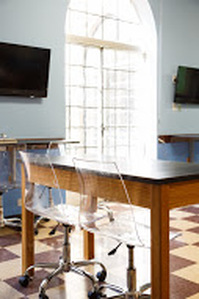 Pilgrim School Fab Lab
Pilgrim School Fab Lab
This site has been created to house resources for teachers, librarians, media literacy specialists and administrators who want to know more about creating innovative spaces on their campus. These spaces go by different names, FabLabs, Idea Labs, and Maker Spaces. The idea behind them all is to create a space for learners young and old to have access to space, tools and other people. This is a place that encourages creative thinking, tinkering and learning through exploring the design process and bringing what was once only imagined, to life.
What's in a name?
Fab Lab, Maker Space, Idea Lab, Innovation Lab, Hackerspace, many names for a space to learn and design.
The name Fab Lab comes from MIT (see TED TALK below), the idea behind the Fab Lab is to create a space for students to be able to design and create anything they can imagine. It also may be called an Innovation Lab. This environment also often called a Maker Space and is part of the Maker Movement. The Maker Movement works outside the educational community and provides spaces for the public to use, learn and to make the things that they want or need.
There is a current movement to provide these innovative spaces in schools. Often times it is a computer lab or library that is being converted or used for this purpose. The Chicago Public Library has lead the way in this movement. Find about more about their Maker Space here.
Within schools Fab Labs are often spaces that can be used to help faculty change the way they teach. The use of Fab Labs and it's equipment (3-D Printers, CNC machines, laser cutters, milling machine, vinyl cutters, electrical tools, hammers, saws, etc) is utilized by teachers who provide opportunities for students to learn by 'doing' or 'making' and/or to show what has been learned in a given unit of study through the creation of a end of unit project. For example, in one school's Innovation Lab students study about Rome and then design and make their own Roman coins. Read about this on their blog.
The name Fab Lab comes from MIT (see TED TALK below), the idea behind the Fab Lab is to create a space for students to be able to design and create anything they can imagine. It also may be called an Innovation Lab. This environment also often called a Maker Space and is part of the Maker Movement. The Maker Movement works outside the educational community and provides spaces for the public to use, learn and to make the things that they want or need.
There is a current movement to provide these innovative spaces in schools. Often times it is a computer lab or library that is being converted or used for this purpose. The Chicago Public Library has lead the way in this movement. Find about more about their Maker Space here.
Within schools Fab Labs are often spaces that can be used to help faculty change the way they teach. The use of Fab Labs and it's equipment (3-D Printers, CNC machines, laser cutters, milling machine, vinyl cutters, electrical tools, hammers, saws, etc) is utilized by teachers who provide opportunities for students to learn by 'doing' or 'making' and/or to show what has been learned in a given unit of study through the creation of a end of unit project. For example, in one school's Innovation Lab students study about Rome and then design and make their own Roman coins. Read about this on their blog.
|
|
Neil Gershenfled of MIT began the with creating a Fab Lab at MIT. He explains in this TED Talk, how this project started and has grown world wide.
|